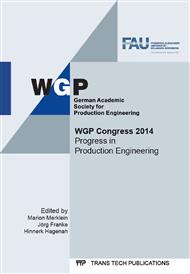[1]
E. Witten, B. Jahn, Composites-Marktbericht 2013, Industrievereinigung verstärkte Kunststoffe und Carbon Composites, (2013).
Google Scholar
[2]
The Council of the European Union, Council Directive 1999/31/EC, Official Journal of the European Union L 182 (1999) 1-19.
Google Scholar
[3]
The Council of the European Union, Council Directive 2000/53/EC, Official Journal of the European Union L 269 (2000) 34-42.
Google Scholar
[4]
European Parliament and the Council, Directive 2008/98/EC, Official Journal of the European Union L 312 (2008) 3-30.
Google Scholar
[5]
A. Hedlund-Aström, Model for end of life treatment of polymer composite materials, dissertation, Stockholm, (2005).
Google Scholar
[6]
G. Marsh, Carbon recycling: A soluble problem, Reinforced Plastics 53 (2009) 22-27.
DOI: 10.1016/s0034-3617(09)70149-3
Google Scholar
[7]
M. Tötzke, Untersuchungen zum Recycling von kohlefaserverstärkten Kunststoffen durch Depolymerisation im Metallbad, Weißensee Verlag, Halle-Wittenberg, Berlin, (2005).
Google Scholar
[8]
M. A. Nahil, P. T. Williams, Recycling of carbon fibre reinforced polymeric waste for the production of activated carbon fibres, Journal of Analytical and Applied Pyrolysis 91(2011) 67-75.
DOI: 10.1016/j.jaap.2011.01.005
Google Scholar
[9]
L. Meyer, K. Schulte, E. Grove-Nielsen, CFRP-Recycling following a pyrolysis route: Process optimization and potentials, Journal of Composite Materials 43 (2009) 1121-1132.
DOI: 10.1177/0021998308097737
Google Scholar
[10]
A. M. Cunliffe, N. Jones, P. T. Williams, Recycling of fibre-reinforced polymeric waste by pyrolysis: Thermo-gravimetric and bench-scale investigations, Journal of Analytical and Applied Pyrolysis 70 (2003) 315-338.
DOI: 10.1016/s0165-2370(02)00161-4
Google Scholar
[11]
A. Greco, A. Mafezzoli, G. Buccoliero, F. Caretto, G. Cornacchia, Thermal and chemical treatments of recycled carbon fibres for improved adhesion to polymeric matrix, Journal of Composite Materials 74 (2012) 369-377.
DOI: 10.1177/0021998312440133
Google Scholar
[12]
R. Piñero-Hernanz, C. Dodds, J. Hyde, J. García-Serna, M. Poliakoff, E. Lester, M. J. Cocero, S. Kingman, S. Pickering, K. H. Wong, Chemical recycling of carbon fibre reinforced composites in nearcritical and supercritical water, Composites Part A: Applied Science and Manufacturing 39 (2008).
DOI: 10.1016/j.compositesa.2008.01.001
Google Scholar
[13]
L. Yuyan, S. Guohua, M. Linghui, Recycling of carbon fibre reinforced composites using water in subcritical conditions, Materials Science and Engineering: A 520 (2009) 179-183.
DOI: 10.1016/j.msea.2009.05.030
Google Scholar
[14]
S. Pimenta, S. T. Pinho, Recycling carbon fibre reinforced polymers for structural applications: Technology review and market outlook, Waste Management 31 (2011) 378-392.
DOI: 10.1016/j.wasman.2010.09.019
Google Scholar
[15]
S. Pickering, Recycling technologies for thermoset composite materials-current status, Composites Part A: Applied Science and Manufacturing 37 (2006) 1206-1215.
DOI: 10.1016/j.compositesa.2005.05.030
Google Scholar
[16]
R. Fukui, T. Odai, H. Zushi, I. Osawa, K. Uzawa, J. Takahashi, Recycle of carbon fiber reinforced plastics for automotive application, 9th Japan international SAMPE symposium, (2005).
Google Scholar
[17]
T. Kirk, Enzymatic combustion,: The microbial degradation of lignin, Annual Review of Microbiology 41 (1987) 465-505.
Google Scholar
[18]
T. Nakajima-Kambe, Y. Shigeno-Akutsu, N. Nomura, F. Onuma, T. Nakahara, Microbial degradation of polyurethane, polyester polyurethanes and polyether polyurethanes, Applied Microbiology and Biotechnology 51 (1999) 134-140.
DOI: 10.1007/s002530051373
Google Scholar
[19]
T. Brueckner, A. Eberl, S. Heumann, M. Rabe, G. Güebitz, Enzymatic and chemical hydrolysis of poly(ethyleneterephthalate) fabrics, Journal of Polymer Science: Part A: Polymer Chemistry 46 (2008) 6435-6443.
DOI: 10.1002/pola.22952
Google Scholar
[20]
J. -D. Gu, T. Ford, K. Thorp und R. Mitchell, Microbial growth on fiber reinforced composite materials, International Biodeterioration & Biodegradation 37 (1996) 197-204.
DOI: 10.1016/s0964-8305(96)00035-2
Google Scholar
[21]
K. Welzel, Einfluss der chemischen Struktur auf die enzymatische Hydrolyse von Polyester-Nanopartikeln, dissertation, Braunschweig, (2003).
Google Scholar


